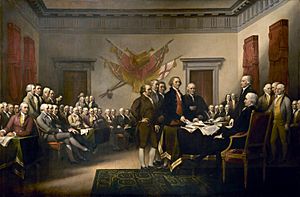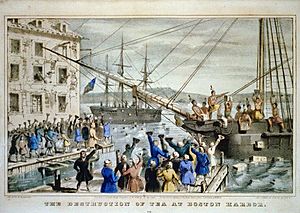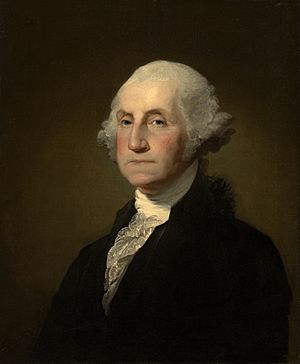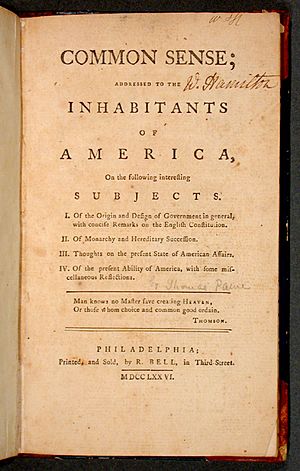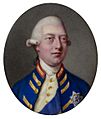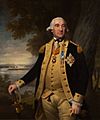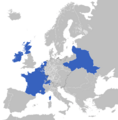American Revolution facts for kids
The American Revolution was a big change that led to the creation of the United States of America. Before this, the thirteen colonies in North America were controlled by the British Empire. The American Revolutionary War (1775–1783) was a key part of this revolution. However, the revolution actually started before the first shot was fired at Lexington and Concord and continued even after the British gave up at Yorktown. Most historians think the revolution began around the time of the French and Indian War (1754–1763) and ended when George Washington became the first President of the United States in 1789.
Contents
Why Did the American Revolution Happen?
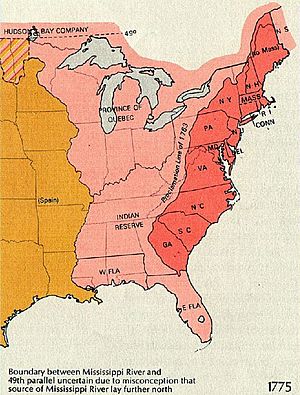
In the early 1760s, Great Britain had a huge empire in North America. After winning the Seven Years' War, Britain also gained control over New France (now Canada), Spanish Florida, and Native American lands east of the Mississippi River. Most white colonists in America saw themselves as loyal British subjects. They believed they had the same rights as people living in Britain.
How Did Religion Influence the Revolution?
The Great Awakening was a religious movement that made people question the power of old religious groups, especially the Church of England. This movement taught people to focus on the Bible rather than on old traditions. This encouraged people to think for themselves and challenge authority.
What Led to the Rebellion?
After the French and Indian War, King George III wanted to keep strong control over North America's land and economy. He made new rules about money and land. The colonists did not like these new rules. Over time, they became very unhappy with how much control the British Crown had over them from far across the ocean. They started to want to rule themselves.
Economic Problems (1760-1770)

In 1760, Britain started looking for more ways to get money from the colonies. This money was meant to help pay off Britain's national debt. Britain thought this was fair because the colonists were benefiting from peace in the New World.
Britain had already passed the Navigation Acts. These laws meant that England controlled all trade and shipping between its colonies and other countries. However, the colonists had found ways to avoid these laws. England did not like this. They began to strictly enforce the Navigation Acts using special search warrants called the Writs of Assistance.
In 1764, more taxes were added. British Prime Minister George Grenville's Sugar Act and Currency Act led to protests. Colonists also started to boycott British goods. The colonists believed that the Parliament should not tax them if they did not have their own representatives in Parliament. They felt that only their local colonial assemblies had the right to tax them. The famous saying "no taxation without representation" became very popular. Groups called Committees of correspondence were formed to organize resistance against British rule.
In 1765, Grenville passed the Stamp Act. This law required all legal documents, newspapers, and even playing cards in the colonies to have a special tax stamp. This was meant to help pay for British troops in North America.
Protests spread throughout the colonies. Secret groups called the Sons of Liberty were formed in every colony. The Stamp Act Congress was also created. It sent a formal protest to Parliament in October 1765. Parliament did cancel the Stamp Act, but they immediately passed the Declaratory Act. This new law said that Parliament's power was the same in America as in Britain. It also stated that Parliament had the right to make laws that the colonies had to follow.
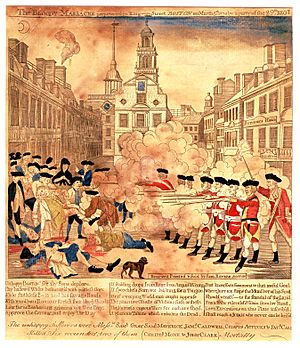
In 1767, Parliament passed the Townshend Acts. These laws put taxes on common goods imported into the colonies, like glass, paint, lead, paper, and tea. Colonists strongly disliked these taxes. Colonial leaders organized boycotts of these British goods. British customs officials took the Liberty, a ship owned by John Hancock, on June 10, 1768. They thought he was smuggling goods. This led to more angry protests in the streets.
British officials told London that Boston was in a state of rebellion. By October 1768, British troops arrived in Boston. The colonists were not happy about having British soldiers in their town. On March 5, 1770, British soldiers fired into an angry crowd, killing five people. This event is known as the Boston Massacre.
Even though the Townshend Acts were cancelled in 1770, the British kept the tax on tea. They wanted to show they still had power over the colonies. For the revolutionaries, who believed only their own representatives could tax them, this one tax was still too much.
Western Land Disputes
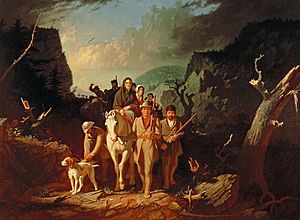
The Proclamation of 1763 said that settlers could not move west of the Appalachian Mountains. However, groups of settlers, some led by Daniel Boone, kept moving west. They often fought with the Shawnee and other Native American groups already living there.
The Quebec Act of 1774 expanded Quebec's borders to the Ohio River. It also brought back French civil law and allowed Roman Catholics to practice their religion in that area.
Major Events Leading to War (1772-1775)
- The Gaspée Affair was when colonists burned a British ship in 1772.
- The Tea Act of 1773 gave the British East India Company a special advantage in selling tea.
- The Boston Tea Party happened on December 16, 1773. Colonists dressed as Native Americans dumped British tea into Boston Harbor.
- The "Intolerable Acts" of 1774 were a series of harsh laws passed by Britain to punish Massachusetts.
- The First Continental Congress met on September 5, 1774, in Philadelphia, Pennsylvania. They supported the Suffolk Resolves, which said the Intolerable Acts were unfair. They also called for people to form militias and for Massachusetts to create its own government.
- The Battle of Lexington and Concord took place on April 19, 1775. These were the first military clashes of the war.
- The Second Continental Congress met on May 10, 1775.
- The Olive Branch Petition was sent on July 5, 1775. This was a final attempt by the Continental Congress to ask King George to address their complaints and avoid more fighting. The King refused to even read the petition.
Who Chose Which Side?
The American revolutionaries were called Patriots (or Whigs or rebels). They all agreed that England had too much power, but they didn't all think the same way. Alexander Hamilton, John Jay, and George Washington wanted to keep wealth and power among the richer people in colonial society. Thomas Jefferson, James Madison, Benjamin Franklin, and Thomas Paine represented those who were not as wealthy or powerful.
Many American colonists stayed loyal to the British Crown. They were known as Loyalists (or Tories or King's men). Like the revolutionaries, this group included both rich and poor people.
The War for Independence (1775-1783)
Main article: American Revolutionary War
Thomas Paine wrote a famous pamphlet called Common Sense. In it, he argued that the only way to solve the problems with Britain was for the colonies to become an independent republic.
- The United States Declaration of Independence was signed, declaring the colonies free from British rule.
- The Articles of Confederation were created as the first plan for the new government.
America After the War
- Shays' Rebellion (1786) was an uprising by farmers in Massachusetts.
- The Northwest Indian War (1785-1795) involved conflicts between American settlers and Native American tribes.
- The Constitutional Convention of 1787 created the United States Constitution.
The American Revolution brought several important changes:
- It introduced the idea of separation of church and state. This ended special privileges for the Anglican Church in the South and the Congregationalist Church in New England.
- It showed that government should be for the people. If people are unhappy with their leaders, they have the right to fight against unfair rule.
- It set up power through written constitutions, which are like rulebooks for the government.
- It proved that the colonies in America could become self-governing nations.
How the Revolution Inspired Others
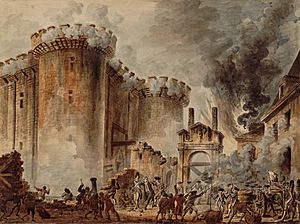
The American Revolution became an example for people in Europe and other parts of the world. For the first time in the Western world, ordinary people had successfully overthrown the rule of a major country. Thinkers of the Enlightenment had written that common people had the right to overthrow unfair governments. The American Revolution proved that it could actually be done. It encouraged people to fight for their own rights.
Other revolutions followed, like the French Revolution, the Haitian Revolution, and the Latin American wars of liberation. Smaller revolutions also happened in Ireland in the 1798 rising, in the Polish-Lithuanian Commonwealth, and in the Netherlands.
In the early 1800s, revolutions broke out in the colonies in South America against Portugal and Spain. Years later, similar revolutions happened in Asia and other places around the world.
Interesting Facts About the American Revolution
- The British tried to keep control over the colonists by passing many laws:
- The Navigation Acts controlled trade.
- The Proclamation of 1763 limited westward expansion.
- The Sugar Act taxed sugar and molasses.
- The Currency Act controlled colonial money.
- The Stamp Act taxed paper goods.
- The Quartering Act made colonists house British soldiers.
- The Declaratory Act stated Parliament's full authority.
- The Townshend Acts taxed imported goods.
- The Tea Act gave a monopoly on tea sales.
- The Intolerable Acts (also called Coercive Acts) punished Massachusetts.
- Many colonists were not angry just because of the taxes. They were upset because they were not represented in Parliament. Later, Americans taxed themselves at higher rates than the British did, but they had representatives in their own government.
- Benjamin Franklin traveled to England to try and make peace. He was made fun of and returned home as a strong Patriot.
- Doctor James Jay (brother of John Jay) created a secret "invisible ink." It was made from ferrous sulfate and water. Messages written with it would disappear and only reappear when heated or treated with a chemical.
- British soldiers were often called "Red Coats" because of their red uniforms.
- The Declaration of Independence does not actually have the word "independence" in its title.
- In 1776, a secret committee found a plan to kill George Washington. The plot was led by his own bodyguard, Thomas Hickey.
- The Treaty of Paris officially recognized the United States as an independent nation.
Images for kids
-
New borders drawn by the Royal Proclamation of 1763
-
Notice of the Stamp Act 1765 in a colonial newspaper
-
Letter III of John Dickinson's Letters from a Farmer in Pennsylvania, published in the Pennsylvania Chronicle, December 1767
-
On June 9, 1772, the Sons of Liberty burned HMS Gaspee, a British customs schooner in Narragansett Bay
-
The December 16, 1773 Boston Tea Party, led by Samuel Adams and Sons of Liberty, has become a mainstay of American patriotic lore.
-
Join, or Die, a political cartoon attributed to Benjamin Franklin was used to encourage the Thirteen Colonies to unite against British rule
-
The British fleet amassing off Staten Island in New York Harbor in the summer of 1776, depicted in Harper's Magazine in 1876
-
The Staten Island Peace Conference in September 1776 depicted in a drawing by Alonzo Chappel
-
Washington crossing the Delaware on December 25–26, 1776, depicted in Emanuel Leutze's 1851 painting
-
Hessian troops hired out to the British by their German sovereigns
-
The 1781 siege of Yorktown ended with the surrender of a second British army, marking effective British defeat.
-
Treaty of Paris by Benjamin West portrays the American delegation about to sign the 1783 Treaty of Paris (John Jay, John Adams, Benjamin Franklin, Henry Laurens, W.T. Franklin). The British delegation refused to pose and the painting was never completed
-
Last page of the 1783 Treaty of Paris, ending the Revolutionary War
-
Robert Morris statue honoring American founding father and financier Robert Morris at Independence National Historical Park in Philadelphia
-
The September 17, 1787 signing of the United States Constitution at Independence Hall in Philadelphia depicted in Howard Chandler Christy's 1940 painting, Scene at the Signing of the Constitution of the United States
-
Portrait of Alexander Hamilton, first Secretary of the Treasury
-
Samuel Adams points at the Massachusetts Charter, which he viewed as a constitution that protected the people's rights, in this c. 1772 portrait by John Singleton Copley
-
Patriots tar and feather Loyalist John Malcolm depicted in a 1774 painting
-
George III as depicted in a 1781 portrait
-
Mercy Otis Warren published poems and plays that attacked royal authority and urged colonists to resist British rule
-
Louis XVI King of France and Navarre
-
Friedrich Wilhelm von Steuben was a former Prussian army officer who served as inspector general of the Continental Army during the American Revolutionary War. He is credited with teaching the Continental Army the essentials of military drill and discipline beginning at Valley Forge in 1778, considered a turning point for the Americans.
-
Thayendanegea, a Mohawk military and political leader, was the most prominent indigenous leader opposing the Patriot forces.
-
An African-American soldier (left) of the 1st Rhode Island Regiment, widely regarded as the first Black battalion in U.S. military history
-
The American Revolution was part of the first wave of the Atlantic Revolutions, an 18th and 19th century revolutionary wave in the Atlantic World
-
A Lexington, Massachusetts memorial to Prince Estabrook, who was wounded in the Battle of Lexington and Concord and was the first Black casualty of the Revolutionary War
-
This postage stamp, which was created at the time of the bicentennial, honors Salem Poor, who was an enslaved African-American man who purchased his freedom, became a soldier, and rose to fame as a war hero during the Battle of Bunker Hill.
-
British Loyalists fleeing to British Canada as depicted in this early 20th century drawing
See also
 In Spanish: Revolución de las Trece Colonias para niños
In Spanish: Revolución de las Trece Colonias para niños


